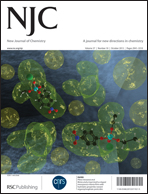Nature of E–E bonds in heavier ditetrel alkyne analogues ArEEAr (Ar = C6H3-2,6(C6H3-2,6-Pri2)2; E = Si, Ge, Sn, and Pb)†
Abstract
The nature of the E–E bonds in heavier ditetrel alkyne analogues ArEEAr (Ar = C6H3-2,6(C6H3-2,6-Pri2)2; E = Si, Ge, Sn, Pb) have been studied by topological analysis of the electron localization function (ELF), the delocalization index from the atoms in molecules (AIM) theory and bond orbital analysis. Both the topological and the orbital analysis show that the nature of the E–E bonds in ArEEAr are different to that of the classical covalent triple C![[triple bond, length as m-dash]](https://www.rsc.org/images/entities/char_e002.gif) C bond of ArC
C bond of ArC![[triple bond, length as m-dash]](https://www.rsc.org/images/entities/char_e002.gif) CAr. In ArEEAr, all of the E–E bonds display charge-shift character; the ELF valence basin centroids of the E–E (E = Ge, Sn) bond do not occupy the central region between the two atoms, but have, in effect, fled that region and split into two kinds of basins. In addition, more and more electrons are transferred from the bond basins of the E–E bond to the lone pair basin of the E atoms, which means that a great portion of the bonding components comes from the lp (lone-pair) orbitals of the E atom rather than the electron-sharing bond, as in
CAr. In ArEEAr, all of the E–E bonds display charge-shift character; the ELF valence basin centroids of the E–E (E = Ge, Sn) bond do not occupy the central region between the two atoms, but have, in effect, fled that region and split into two kinds of basins. In addition, more and more electrons are transferred from the bond basins of the E–E bond to the lone pair basin of the E atoms, which means that a great portion of the bonding components comes from the lp (lone-pair) orbitals of the E atom rather than the electron-sharing bond, as in


 Please wait while we load your content...
Please wait while we load your content...